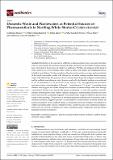Por favor, use este identificador para citar o enlazar a este item:
http://hdl.handle.net/10261/306951COMPARTIR / EXPORTAR:
 SHARE SHARE
 CORE
BASE CORE
BASE
|
|
| Visualizar otros formatos: MARC | Dublin Core | RDF | ORE | MODS | METS | DIDL | DATACITE | |

| Título: | Domestic Waste and Wastewaters as Potential Sources of Pharmaceuticals in Nestling White Storks (Ciconia ciconia) |
Autor: | Blanco, Guillermo CSIC ORCID ; Gómez-Ramírez, Pilar CSIC ORCID; Espín, Silvia; Sánchez-Virosta, Pablo; Frías, Óscar; García-Fernández, Antonio J. | Palabras clave: | Ecopharmacovigilance Pharmaceutical pollution Human medicines Rubbish dumps Veterinary drugs Wildlife |
Fecha de publicación: | 5-mar-2023 | Editor: | Multidisciplinary Digital Publishing Institute | Citación: | Antibiotics 12: 520 (2023) | Resumen: | Information on the exposure of wild birds to pharmaceuticals from wastewater and urban refuse is scarce despite the enormous amount of drugs consumed and discarded by human populations. We tested for the presence of a battery of antibiotics, NSAIDs, and analgesics in the blood of white stork (Ciconia ciconia) nestlings in the vicinity of urban waste dumps and contaminated rivers in Madrid, central Spain. We also carried out a literature review on the occurrence and concentration of the tested compounds in other wild bird species to further evaluate possible shared exposure routes with white storks. The presence of two pharmaceutical drugs (the analgesic acetaminophen and the antibiotic marbofloxacin) out of fourteen analysed in the blood of nestlings was confirmed in 15% of individuals (n = 20) and in 30% of the nests (n = 10). The apparently low occurrence and concentration (acetaminophen: 9.45 ng mL−1; marbofloxacin: 7.21 ng mL−1 ) in nestlings from different nests suggests the uptake through food acquired in rubbish dumps rather than through contaminated flowing water provided by parents to offspring. As with other synthetic materials, different administration forms (tablets, capsules, and gels) of acetaminophen discarded in household waste could be accidentally ingested when parent storks forage on rubbish to provide meat scraps to their nestlings. The presence of the fluoroquinolone marbofloxacin, exclusively used in veterinary medicine, suggests exposure via consumption of meat residues of treated animals for human consumption found in rubbish dumps, as documented previously at higher concentrations in vultures consuming entire carcasses of large livestock. Control measures and ecopharmacovigilance frameworks are needed to minimize the release of pharmaceutical compounds from the human population into the environment. | Versión del editor: | https://doi.org/10.3390/antibiotics12030520 | URI: | http://hdl.handle.net/10261/306951 | DOI: | 10.3390/antibiotics12030520 | ISSN: | 2079-6382 |
| Aparece en las colecciones: | (MNCN) Artículos |
Ficheros en este ítem:
| Fichero | Descripción | Tamaño | Formato | |
|---|---|---|---|---|
| Blanco_G_Domestic.pdf | artículo principal | 1,43 MB | Adobe PDF |  Visualizar/Abrir |
CORE Recommender
SCOPUSTM
Citations
4
checked on 20-abr-2024
WEB OF SCIENCETM
Citations
2
checked on 22-feb-2024
Page view(s)
22
checked on 28-abr-2024
Download(s)
28
checked on 28-abr-2024
Google ScholarTM
Check
Altmetric
Altmetric
Este item está licenciado bajo una Licencia Creative Commons

